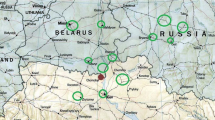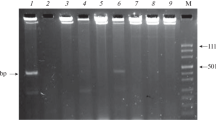Abstract
BOTH point mutations and structural aberrations of chromosomes are induced by ionising radiations, causing genetic variation and abnormalities in man and other organisms. The mutagenic effects are dose dependent and in Drosophila a linear relationship between dose and mutation rate has been shown for doses up to 5 R (ref. 1). Although man accumulates approximately 5 R of radiation from the environment in 30 yr of reproductive life, it is not known whether this is of any radio-biological consequence2. Nor is it known whether in man there is a threshold phenomenon at low doses (several hundred or thousand mr. per year), although there is greater repair of mutational or pre-mutational damage after low-dose irradiation3. In a coastal area of Kerala, South India, the background radiation is 1,500–3,000 mr. Yr−1 due to the presence of thorium-containing monazite mineral in the soil4–7 (Fig.1). A survey of the rat population in this area with respect to several measurable and non-measurable traits and of humans with regard to dermatoglyphics and demographic data such as fertility index, sex ratio and infant mortality rate revealed no mutational effects4,7,8. During an epidemiological study of nodular lesions of the thyroid in this area9, we noticed an apparently high prevalence of Down's syndrome and other forms of severe mental retardation10. We therefore made a house-to-house survey of developmental abnormalities in this area and in a comparable control area without high background radiation7 (Fig. 1). We also determined the frequency of chromosome aberrations in a sample of the normal population living in the study and control areas. The observations we report here support the view that radiation-induced genetic anomalies occur with above average frequency in the population living in the area with high background radiation. The area surveyed was the southernmost one-fifth of the Chavara-Neendakara strip (Fig. 1). In the thatched huts which constitute 75% of all households, the exposure risk is 1,500–3,000 mr. Yr−1, and personal exposure, as measured by calcium fluoride dosimeters, closely parallels the exposure risk in the households. The control area consisted of the Purakkade–Punnapura villages, with a background radiation of approximately 100 mr. yr−1 (ref. 7). Households were visited repeatedly to ensure examination of all members. Only gross abnormalities evident on clinical examination were recorded. Cytogenetic abnormalities were scored blind on slides prepared from 64-h micro-blood cultures11.
Similar content being viewed by others
References
Glass, H. R., and Ritterhoff, R. K., Science, 133, 1366 (1961).
Gr¨neberg, H., Nature, 204, 222–224 (1964).
Russell, W. L., Brookhaven Symp. Biol., 20, 179–189 (1968).
Grüneberg, H., et al. Med. Res. Council Spec. Rep. Ser., Lond., 307 (1966).
WHO Tech. Rep. Ser., 166, 23 (1959).
Ponnunni Kartha, K. I., Hlth Phys., 15, 368–369 (1968).
Gopal Ayengar, A. R., et al., in Peaceful Uses of Atomic Energy, 11, 31–51 (International Atomic Energy Agency, Vienna, 1972).
Ahuja, Y. R., Sharma, A., Nampoorthiri, U. K., Ahuja, M. R., and Dempster, E. R., Hum. Biol., 45, 167–179 (1973).
Kochupillai, N., Thangavelu, M., and Ramalingaswami, V., Indian J. med. Res. (in the press).
WHO Tech. Rep. Ser., 392, 8 (1968).
Arakaki, D. T., and Sparkes, R. S., Cytogenetics, 2, 57–60 (1963).
Penrose, L. S., and Smith, G. F., in Down's Anomaly (Churchill, London, 1966).
Ross, H. S., Innes, G., and Kidd, C., Scot. med. J., 12, 260–263 (1967).
Verma, I. C., and Singh, M. B., Lancet, i 1200 (1975).
Hillard, L. T., and Kirman, B. H., Mental Deficiency, 310 (Churchill, London, 1957).
Verma, I. C., Gupta, A. K., Devanagondi, B. S., Indian Pediat., 12, 1239–1245 (1975).
Alberman, E., et al. Ann. Hum. Genet., Lond., 36, 195–208 (1972).
Uchida, I. A., and Curtis, E. J., Lancet, ii, 848–850 (1961).
Yamamoto, M., Shimada, M., Ende, A., and Watanabe, G., Nature new Biol., 244, 206–208 (1973).
Barcinski, M. A., et al. Am. J. Hum. Genet., 27, 802–806 (1975).
Summitt, R. L., J. Pediat., 74, 58–66 (1969).
Report of the Advisory Committee on the Biological Effects of Ionizing Radiation, 47 (National Academy of Sciences, Washington DC, 1972).
Kirman, B. H., in Mental Retardation and Developmental Disabilities, 5, Clinical Aspects (edit. by Wortis, J.), 1–24 (Butterworths, London, 1973).
Author information
Authors and Affiliations
Rights and permissions
About this article
Cite this article
KOCHUPILLAI, N., VERMA, I., GREWAL, M. et al. Down's syndrome and related abnormalities in an area of high background radiation in coastal Kerala. Nature 262, 60–61 (1976). https://doi.org/10.1038/262060a0
Received:
Accepted:
Issue Date:
DOI: https://doi.org/10.1038/262060a0
- Springer Nature Limited
This article is cited by
-
Assessment of radiation hazard indices due to naturally occurring long-life radionuclides in the coastal area of Barra de Valizas, Uruguay
Environmental Geochemistry and Health (2023)
-
Study of stillbirth and major congenital anomaly among newborns in the high-level natural radiation areas of Kerala, India
Journal of Community Genetics (2013)
-
Chromosome aberration and environmental physical activity: Down syndrome and solar and cosmic ray activity, Israel, 1990–2000
International Journal of Biometeorology (2005)
-
Chernobyl, low-dose radiation, and trisomy 21: Possibly something to worry about
European Journal of Pediatrics (1996)
-
Solar activity cycle and the incidence of foetal chromosome abnormalities detected at prenatal diagnosis
International Journal of Biometeorology (1995)





